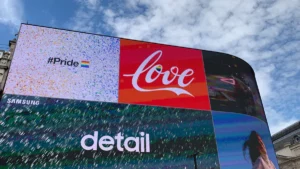For information about how Screenfluence can help your business with digital signage, please don’t hesitate to contact us by calling 1-844-772-7336 or emailing info@screenfluence.com.
Contact UsThe Best Practices For Designing Digital Signage Content
In recent years
digital signage has rapidly grown its reputation as a powerful marketing tool. It enables businesses to showcase their products, services and brand messaging to a wide audience. However, simply putting up a display screen with some basic content doesn’t exactly cut it. To be effective, digital signage content must be well-designed and thoughtfully executed. The key is to attract and engage your audience.
What are the best practices for designing digital signage content?
Speak to your target audience.
You should know who your target audience is, what they want and what type of content they respond to. Without this knowledge, you risk creating content that doesn’t resonate with your audience and fails to achieve your marketing goals.
To create content that resonates with your audience, you need to understand their needs, wants, and pain points. One way to do this is by conducting market research, surveys and focus groups to gather information about your audience. With this information, you can create content that addresses their needs and desires. This will make it more likely that they will engage with your digital signage.
Define your objectives.
What is the purpose of your signage? Are you promoting a product, highlighting a service or sharing important information? By defining your objectives, you can tailor your content to achieve your desired outcomes.
For example, if your objective is to promote a new product, you may want to create content that showcases the product’s features and benefits. On the other hand, if your objective is to share important information, you may want to create content that is easy to read and visually engaging. Defining your objectives will help you create content that resonates with your audience and achieves your goals.
Keep the content simple.
When it comes to digital signage content, less is more. People are bombarded with countless messages every day, so it’s essential to keep your content simple and to the point. Your content should be easy to read, understand, and remember. So, keep your messaging short and sweet.
To create effective digital signage content, you should focus on establishing a clear and concise message that resonates with your audience. Avoid using complicated language, jargon or technical terms that your audience may not understand. Instead, use simple and straightforward language that is easy to understand and remember.
Use high-quality images and videos.
Images and videos are more engaging than text. It’s essential to use high-quality visuals that capture your audience’s attention and convey your message effectively. When choosing images and videos for your digital signage content, you should focus on high-resolution and high-quality visuals that are visually appealing and relevant to your message.
As well, you should ensure that your images and videos are appropriate for the environment where they will be displayed. For example, if your digital signage is in a bright and sunny location, you may need to adjust the brightness and contrast of your visuals to ensure they are visible and easy to read.
Create eye-catching design.
Your digital signage design should be eye-catching, attractive and memorable. Your design should be simple, yet visually appealing. It should always complement your messaging. Using bold, contrasting colours, clean typography and visually appealing graphics can help make your digital signage stand out from the crowd.
When designing your digital signage content, you should also consider the size and placement of your visuals. It’s wise to use large, bold visuals that are easy to read from a distance. Also, ensure that your messaging is visible from all angles.
Use calls-to-action.
Calls-to-action are powerful tools for encouraging your audience to take action, such as making a purchase or visiting your website. When designing digital signage content, consider incorporating calls-to-action that are relevant to your objectives.
For example, if your objective is to promote a new product, consider using a call-to-action that encourages your audience to make a purchase. Similarly, if your objective is to drive traffic to your website, consider using a call-to-action that directs your audience to your website.
Consider your location.
The environment in which your content is displayed can greatly affect its effectiveness. For example, if your display screen is in a busy area with lots of distractions, it may be difficult to capture your audience’s attention. Consider the size and placement of your display screen, as well as the lighting and background of your location. These factors can greatly affect the readability and effectiveness of your content.
For information about how Screenfluence can help you with the design of your digital signage, please don’t hesitate to contact us by calling 1-844-772-7336 or emailing info@screenfluence.com.


